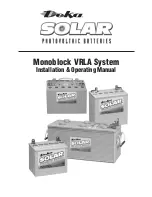
8
Capacity Testing
continued
The test is conducted by discharging a fully charged battery at
a specific rate until the battery voltage drops to a
predeter¬mined volts per battery, times the number of batter-
ies in the battery system. By noting the time elapsed between
when the battery was put on discharge and when the final volt-
age was reached, you can determine whether the battery is
delivering its rated capacity:
1. Give the battery an equalizing charge until the current has
stabilized. Start the test and record the starting time.
2. Record individual battery voltages and overall battery sys-
tem voltages during the first hour at 10 minutes, 30 min-
utes and then 60 minutes. After the first hour, take hourly
readings until the first battery voltage reaches 10.80 volts
per battery. From this point on, record the voltage of the
batteries every 5 minutes. monitor the voltage of the low
batteries and as the voltage of each battery drops below
the predetermined final voltage, record the time.
3. When the majority of the batteries reach termination value,
stop the test. Don’t let any battery go into reversal.
For example, if the test was run at the 360 minute rate was ter-
minated after 336 minutes; the capacity percentage would be
93%
4. If the battery system delivers 50% or more of its rated
capacity, it can be returned to service. If the test indicates
less than 50% of the battery’s rated capacity is being deliv-
ered, the battery system should be either repaired or
replaced, depending upon its age and overall condition.
For more detailed information on capacity testing, contact
East Penn Manufacturing Company or your local authorized
East Penn Representative.
GLOSSARY:
AGM – Absorbed Glass Mat –
A class of VRLA (Valve
Regulated Lead-Acid) battery in which the electrolyte is
absorbed into a glass mat.
Ambient Temperature –
The average temperature of the
battery room. Temperatures below 77°F (25°C) will reduce
battery capacity. Temperatures above 77°F (25°C) will
reduce battery service life.
Amp Hour (Ah) –
Amps times Hours
Battery Efficiency – The amount of Ah return required to
achieve full SOC vs. the amount of Ah removed during dis-
charge. Require 110% to 115% Ah return
Capacity –
The capacity of a battery is specified as the
number of Amp-Hrs that the battery will deliver at a specific
discharge rate and temperature. The capacity of a battery is
not a constant value and is seen to decrease with increasing
discharge rate.
C
20
–
Battery capacity measured in Ah (amp hour) at the
20hr rate.
End Voltage –
The minimum voltage at which a DC system
will operate.
Flooded – A battery in which the products of electrolysis
and evaporation are allowed to escape to the atmosphere
as they are generated. Electrolyte is free flowing throughout
the battery.
Gel –
A class of VRLA (Valve Regulated Leda-Acid) battery
in which the electrolyte is immobilized in a gel form (sulfuric
acid mixed with silica)
Parallel –
A circuit that provides more than one path for the
flow of current. A parallel arrangement of batteries (usually
of like voltages and capacities) has all positive terminals
connected to a conductor and all negative terminals con-
nected to another conductor. If two 12-volt batteries of 50
ampere-hour capacity each are connected in parallel, the
circuit voltage is 12 volts, and the ampere-hour capacity of
the combination is 100 ampere-hours.
Series –
A circuit that has only one path for the flow of
current. Batteries arranged in series are connected with
negative of the first to positive of the second, negative of the
second to positive of the third, etc. If two 12-volt batteries of
50 ampere hours capacity each are connected in series, the
circuit voltage is equal to the sum of the two battery volt-
ages, or 24 volts, and the ampere-hour capacity of the com-
bination is 50 ampere-hours.
SOC (State of Charge) –
The amount of deliverable
low-rate electrical energy stored in a battery at a given time
expressed as a percentage of the energy when fully charged
and measured under the same discharge conditions. If the
battery is fully charged the “SOC” is said to be 100%.
Temperature Correction –
A factor used to compensate for
battery capacity and/or adjust battery voltage at ambient
temperatures greater than or less than 77°F (25°C).
Undercharge (Deficit charge) –
Charging a battery with less
ampere-hours (Ah) than is required to return the battery to
its initial state-of-charge. This results in a reduction in the
battery state-of-charge.
VPC –
Volts per Cell
VRLA –
Valve Regulated Lead Acid – a lead-acid cell/battery
that is sealed with exception of a valve that opens to the
atmosphere when the internal gas pressure exceeds atmos-
pheric pressure by a pre-selected amount. VRLA batteries
provide a means for recombination of internally generated
oxygen and the suppression of hydrogen gas evolution to
limit water consumption
Summary of Contents for SOLAR Monoblock VRLA System
Page 1: ...Monoblock VRLA System Installation Operating Manual ...
Page 12: ...10 APPENDIX B Example of typical 3 stage charger ...
Page 13: ...11 APPENDIX C Depth of Discharge vs Freezing Point ...
Page 14: ...12 APPENDIX D Capacity vs Operating Temperature ...
Page 16: ...14 APPENDIX F Charging Current vs Charging Time chart Discharge Voltage Curve ...
Page 17: ...APPENDIX G ...




































